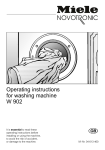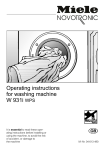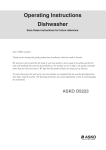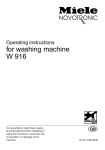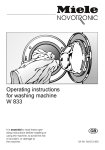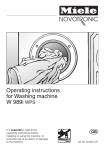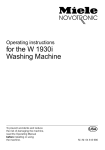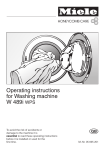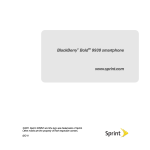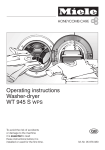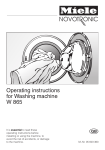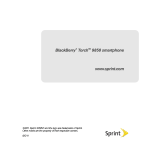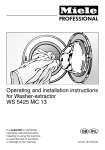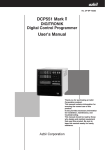Download Miele W 937 wps Operating instructions
Transcript
Operating instructions
for Washing machine
W 937 WPS
It is essential to read these
operating instructions before
installing or using the machine, to
avoid the risk of accident, or damage
to the machine.
Q
M.-Nr. 04 610 490
Contents
Contents
Guide to the machine. . . . . . . . . . . . . . . . . . . . . . . . . . . . . . . . . . . . . . . . . . . . . . . 3
Warning and Safety Instructions . . . . . . . . . . . . . . . . . . . . . . . . . . . . . . . . . . . . . 5
Preparation for use
Help to protect our environment . . . . . . . . . . . . . . . . . . . . . . . . . . . . . . . . . . . . . . . 8
Installation . . . . . . . . . . . . . . . . . . . . . . . . . . . . . . . . . . . . . . . . . . . . . . . . . . . . . . . 36
Plumbing . . . . . . . . . . . . . . . . . . . . . . . . . . . . . . . . . . . . . . . . . . . . . . . . . . . . . . . . 42
Electrical connection . . . . . . . . . . . . . . . . . . . . . . . . . . . . . . . . . . . . . . . . . . . . . . . 46
Operation
Washing environmentally and economically . . . . . . . . . . . . . . . . . . . . . . . . . . . . . . 9
How to wash correctly . . . . . . . . . . . . . . . . . . . . . . . . . . . . . . . . . . . . . . . . . . . . . . 10
To change a programme . . . . . . . . . . . . . . . . . . . . . . . . . . . . . . . . . . . . . . . . . . . . 14
Adding or removing washing after programme start . . . . . . . . . . . . . . . . . . . . . . . 15
Adding detergent . . . . . . . . . . . . . . . . . . . . . . . . . . . . . . . . . . . . . . . . . . . . . . . . . . 16
Fabric conditioners/starch formulations. . . . . . . . . . . . . . . . . . . . . . . . . . . . . . . . . 17
Programme selection . . . . . . . . . . . . . . . . . . . . . . . . . . . . . . . . . . . . . . . . . . . . . . . 18
Programme sequence . . . . . . . . . . . . . . . . . . . . . . . . . . . . . . . . . . . . . . . . . . . . . . 20
Care symbols . . . . . . . . . . . . . . . . . . . . . . . . . . . . . . . . . . . . . . . . . . . . . . . . . . . . . 22
Additional options . . . . . . . . . . . . . . . . . . . . . . . . . . . . . . . . . . . . . . . . . . . . . . . . . 23
Delay start/time left display . . . . . . . . . . . . . . . . . . . . . . . . . . . . . . . . . . . . . . . . . . 24
Maintenance
Cleaning and care . . . . . . . . . . . . . . . . . . . . . . . . . . . . . . . . . . . . . . . . . . . . . . . . . 25
Problem solving guide . . . . . . . . . . . . . . . . . . . . . . . . . . . . . . . . . . . . . . . . . . . . . . 29
After sales service . . . . . . . . . . . . . . . . . . . . . . . . . . . . . . . . . . . . . . . . . . . . . . . . . 35
Programmable functions
Programmable functions . . . . . . . . . . . . . . . . . . . . . . . . . . . . . . . . . . . . . . . . . . . . 47
Consumption data . . . . . . . . . . . . . . . . . . . . . . . . . . . . . . . . . . . . . . . . . . . . . . . . 49
Technical Data . . . . . . . . . . . . . . . . . . . . . . . . . . . . . . . . . . . . . . . . . . . . . . . . . . . . 50
2
Guide to the machine
Guide to the machine
1 Electric supply cable
6 Drum door
2 Inlet hose with "Waterproof" system
7 Access panel for drain pump and filter
3 Flexible drain hose (with detachable
swivel elbow)
8 Four height adjustable feet
4 Detergent dispenser drawer
9 Access panel for energency door release and emptying
5 Facia panel with controls
3
Guide to the machine
Detergent dispenser drawer
Compartment i Pre-wash
Compartment j main wash
Compartment p (with extra lid)
for fabric conditioner or
liquid starch formulation
b
"I-On/O-Off" button
h
SPIN SPEED display
with “$” and “>” touch pads
c
"Door" button
d
CHECK LIGHTS
i
PROGRAMME SEQUENCE display
with “*” touch pad.
e
Touch pads for PROGRAMMES
j
"TIME" display
f
Touch pads for ADDITIONAL
OPTIONS
k
“START” touch pad
l
g
TEMPERATURE DISPLAY and
“$” and “>” touch pads.
Delay start d touch pad
with “$” and “>” touch pads
4
Warning and Safety Instructions
Warning and Safety Instructions
Read the operating instructions before using this machine for the first
time. They contain important information about the safety, use and
maintenance of the machine. This
will avoid the risk of accidents and
damage to the machine.
Keep these operating instructions in
a safe place and ensure that new
users are familiar with the content.
Pass them on to any future owner of
the machine.
The electrical safety of this machine can only be guaranteed
when continuity is complete between
the machine and an effective earthing
system which complies with local and
national regulations. It is most important that this basic safety requirement is
regularly tested by a qualified electrician.
The manufacturer cannot be held responsible for the consequences of an
inadequate earthing system.
Correct usage
For safety reasons do not operate
this appliance on an extension
cable. Danger of overheating.
Only use the washing machine to
wash items which are declared by
the manufacturer to be machine-washable on the wash-care label.
Any other applications may be dangerous. The manufacturer is not liable
for damage resulting from improper
use or operation.
This appliance should not be operated by children. Supervise its use
by the elderly or infirm.
Technical safety
Before setting up the machine,
check it for any exernally visible
damage.
The machine is built in accordance
with current safety requirements.
Unauthorised repairs could result in unforeseen dangers for the user, for
which the manufacturer cannot accept
responsibility. Repairs should only be
undertaken by a Miele approved engineer.
The machine is only completely isolated from the electricity supply
when:
– it is switched off at the wall socket
and the plug is withdrawn, or
– it is switched off at the mains, or
– the mains fuse is withdrawn.
Before connecting the machine, ensure that the connection data on
the data plate (fusing, voltage and frequency) matches the mains electricity
supply. If in any doubt, consult a qualified electrician.
5
Warning and Safety Instructions
The Miele "Waterproof system" protects from water damage provided
the following conditions have been met:
– the machine is correctly plumbed in
and connected to the electricity supply.
– if a fault has been identified, the machine must be examined by a competent person before further use and
repaired if necessary.
Faulty components must only be
exchanged for Miele original spare
parts. Only when these parts are fitted
can the safety standards of the machine be guaranteed.
If the connection cable is damaged it must be replaced by a special Miele cable.
Use
Do not install your washing machine in rooms where temperatures below freezing may occur.
Frozen hoses may burst under pressure. The reliability of the electronic control system may be impaired at temperatures below freezing point.
In countries where there are areas
which may be subject to infestation by cockroaches or other vermin,
pay particular attention to keeping the
appliance and its surroundings in a
clean condition at all times. Any damage which may be caused by cockroaches or other vermin will not be
covered by the appliance guarantee.
6
Before using the machine for the
first time, check that the transit fitting at the rear of the machine has
been removed (see section on "Installation"). During spinning, a transit fitting
which is still in place may result in damage to both the machine and adjacent
furniture or appliances.
Turn off the stopcock if the machine will be left for any length of
time (e.g. holiday), especially if there is
no floor drain (gully) in the immediate vicinity.
Flooding danger.
If hooking the drain hose into a
wash basin, check that the water can
drain off quickly enough to prevent the
sink from overflowing.
Make sure the drain hose is secure, so
that the force of the water flowing out of
the hose does not dislodge it. Otherwise this will result in flooding.
Take care to ensure that foreign objects (e.g. nails, needles, coins,
paper clips, etc.) do not find their way
into the machine with the washing (e.g.
in pockets). Foreign objects can damage components of the machine, which
in turn can result in damage to the
washing.
Warning and Safety Instructions
If the correct amount of detergent
is dispensed, the machine should
not need to be descaled. If, however,
you do wish to descale the machine
only use proprietary non-corrosive descaling agents and strictly observe the
instructions. Consult the Miele Customer Service Department.
Textiles which have been pretreated in solvent based cleaning
agents must be thoroughly rinsed in
clean water before being washed in the
machine.
Never use solvent based cleaning
agents in this machine, as this may
result in damage to component parts
and create toxic fumes. Such detergents also pose a fire and explosion hazard.
Only use dyes specified by the
manufacturer as being suitable for
use in a washing machine. Always observe the manufacturer’s instructions
carefully.
Always make sure the drum is stationary before reaching in to
remove washing. Reaching into a moving drum is extremely dangerous.
This machine is intended for domestic use, and the guarantee is
on this understanding. If the machine is
used in a commercial environment, the
user is responsible for ensuring conformity to all relevant regulations.
Accessories
Accessory parts may only be fitted
when expressly approved by
Miele. If other parts are used, guarantee, performance and product liability
claims may be invalidated.
Disposal of your old machine
Before discarding an old machine
unplug it. Render the plug useless.
Cut off the cable directly behind the appliance to prevent misuse.
Dye removers may contain sulphur
compounds which cause damage
such as corrosion to the machines. Do
not use dye removers in this machine.
For machines with a ’porthole’
door, remember that the porthole
glass will be hot when washing at very
high temperatures. Do not let children
touch it during a hot wash programme.
7
Help to protect our environment
Help to protect our environment
Disposal of the packing
material
The transport and protective packing is
mostly manufactured from the following
recycled or re-useable materials:
– corrugated paper/card
– polystyrene - CFC-free
– untreated surplus wood
– chipboard, contains no phenolic
resins
– polyethylene foil (PE)
– packaging straps: polyropylene (PP)
Rather than just throwing these materials away, please take them to the
nearest local authority collection point
for specific waste.
8
Disposal of your old machine
Old machines may contain material
which can be reclaimed or recycled.
Please contact your dealer, your local
waste collection centre or scrap merchant about potential recycling
schemes.
Ensure that the machine presents no
danger to children while being stored
for disposal.
See the appropriate section in the
Warning and Safety instructions.
Washing environmentally and economically
Washing environmentally and economically
Caring for the environment means savEconomy tips
ing water, energy and detergent when
To help you wash most economically,
washing but without compromising on
remember the following tips:
results.
The key to a good wash result is finding – The automatic load control facility
allows you to wash individual loads
the best combination of amount of
of between 1 and 5 kg. Ideally wash
detergent, temperature, length of prowith the maximum load specified for
gramme and the machine’s technology.
each programme. This uses the enIf necessary, some programmes take
ergy to the best advantage.
longer to achieve this effect. With the
– Only use the correct amount of deter"Hydromatic" system, the drum can regent required for the water hardness
volve at different speeds. Longer and
level in your area, according to the
slower action together with pauses for
detergent manufacturer’s recommensteeping, work towards a good result.
dations.
The automatic load control facility en– If washing is not heavily stained, sesures the correct water level for the
lect a lower temperature setting than
type of fabric and laundry load being
indicated on the wash care label but
washed. Sometimes it even appears
do not additionally select "Short".
that there is no water in the drum.
– Use the "Short wash" option for washNormally, main wash is sufficient for a
ing that is only very lightly soiled, but
clean result, so a pre-wash is not autodo not additionally reduce the temmatically included in the programmes.
perature.
If it is wanted, a simple press on the
pre-wash selector includes it.
– Using the additional "Soak" option
allows you to reduce the temperature used in the main wash.
9
How to wash correctly
How to wash correctly
The headings numbered (1,2,3,...)
show the operating sequense and can
be used as a brief guide.
Before washing
1
Prepare the wash load
Dark textiles often contain excess dye
and should be washed separately several times before being included in a
mixed load.
Delicate textiles should be washed separately in a delicates programme.
Any loose wiring in bras etc., should be
removed or sewn in.
Only wash textiles made from wool or
wool mixtures if the textile care label
states that they are suitable for machine washing.
Pre-treating the washing
Empty all pockets.
Foreign objects (e.g. nails, coins,
paper clips etc) can cause damage
to textiles and components in the
machine.
Sort the washing
Most garments have a textile care label
in the collar or side seam. Sort the
washing by care label symbols. (See
the Section on these symbols for their
explanation).
Only wash items in this machine which
are declared by the manufacturer as
being machine washable on the textile
care label.
10
Badly soiled areas, e.g. collars and
cuffs, and water soluble stains can be
pre-treated with bar soap, liquid detergent or detergent mixed into a solution
or paste.
With particularly stubborn stains ask
your Dry Cleaner for advice.
Do not use solvent based cleaning
agents in this machine.
2
Open the door by pressing on the
"Door" button.
How to wash correctly
3
Load the drum.
Unfold washing and load loosely in the
drum. To achieve best results it is advisable to make up mixed loads consisting of both large and small items.
This improves the washing effect and
helps distribute the load evenly to keep
the machine stable and reduce the
noise level during spinning.
Overloading reduces the wash result
and causes more creasing.
Maximum load weights are noted
below:
To start a programme
1
Press the I-ON/0-OFF button.
2
Select the required basic
programme.
See page 13 for details of the Memory
function.
3
Select an additional option
if required.
For a delayed start, see Section on the
"Delay start" and "time left display" for
details.
COTTONS . . . . . . . . . . . . . . . . . . 5.0 kg
MINIMUM IRON . . . . . . . . . . . . . . 2.5 kg
4
Select the temperature by
pressing the “$” or “>” touch
pad beneath the temperature
display.
5
Select the spin speed by
pressing the “$” or “>” touch
pad beneath the spin display.
6
Press the START button.
DELICATES/SYNTHETICS . . . . . 1.0 kg
WOOL . . . . . . . . . . . . . . . . . . . . . 1.0 kg
QUICK WASH . . . . . . . . . . . . . . . 2.5 kg
Curtains:
Remove lead weights and strips or
place in a laundry bag.
Any loose wiring in bras etc., should be
removed or swen in.
Woollens, knitted garments and jeans:
Turn inside out, if the manufacturer recommends it.
3
Close the drum door.
Make sure that there is no obstruction
between the drum door and seal.
4
Open the stopcock.
5
Add detergent.
See Section on Detergent for details.
11
How to wash correctly
After washing
1
Press the “Door” button.
2
Remove the washing.
Only remove washing from the machine once the drum has stopped
turning, otherwise you may seriously injure yourself.
Make sure the drum is empty, items
left behind could shrink, or discolour other items in the next wash.
4
Otherwise there is a danger of objects
being placed inadvertently in the drum.
If these remained unnoticed and were
washed in the next load, they could
damage the washing.
5
3
12
Check the folds in the door seal
for any small articles e.g. buttons
which might be lodged there.
Close the drum door.
Press the I-ON/0-OFF button.
How to wash correctly
Memory-Function
Note:
As soon as the basic programme has
been selected, the indicator lights for
the ADDITIONAL OPTIONS, TEMPERATURE and SPIN SPEED set the last
time this programme was used automatically illuminate.
If a touch pad is pressed which is not
accepted by the basic programme, the
indicator light will go out when the
touch pad is released (if selecting an
additional option), or the command will
be completely ignored (if selecting a
temperature and spin speed).
To run the programme with the selections already shown:
Press the START button.
To cancel or change any of the selections retained in the memory and displayed:
– ADDITIONAL OPTIONS - to cancel,
press on the illuminated touch pad;
to change, press on the touch pad
for the option required.
– SPIN - press the spin “$” or “>”
touch pad .
– TEMPERATURE - press the temperature “$” or “>” touch pad.
The additional options, temperature
and spin speed can only be selected within the permitted range of
the basic programme chosen.
13
To change a programme
To change a programme
Changing a programme once
started:
Changing a basic programme once
started:
This is only possible by starting again
completely.
Switch the machine off and then on
again and select a new programme.
To skip a programme stage:
Press the “*” touch pad when the
programme reaches the stage you
want to skip:
The programme will then continue in
the next programme stage. The corresponding segment in the programme
sequence display illuminates.
To repeat a programme stage:
Changing additional options, temperature and spin speed:
This can be done if the change is compatible with the basic programme.
Exception: If the programme locking
child safety feature has been set,
changes are only possible by starting
again.
14
Switch the machine off and on again.
Select the programme.
Press the “START” button.
Keep pressing the “*” touch pad
until the programme stage to be repeated has been reached.
Adding or removing washing after programme start
Adding or removing washing after programme start
Washing can be added or removed
QUICK WASH
after the programme has already
The door can be opened during the folstarted, when using the following prolowing programme stage:
grammes:
– Main wash
– COTTONS
– MINIMUM IRON
– QUICK WASH 40°C
Press the "Door" button in and hold it
until the door springs open.
– In the SEQUENCE display the segment for the relevant programme is illuminated.
Add or remove items.
Shut the door.
Washing cannot be added later if using
the following additional options or programmable functions:
– “Water plus" (the water level is increased)
– Programme lock (e.g. to prevent
children from opening the door during the wash process).
– The programme continues.
COTTONS and QUICK WASH 40°C
The door can be opened in the following programme stages:
– Soak
– Pre-wash
– Main wash, but only if the suds temperature is less than 55°C.
Please note that the door can only be
opened when the suds temperature is
less than 55°C.
15
Adding detergent
Adding detergent
All modern detergents produced for
automatic washing machines are suitable, including liquid, compact (concentrated) and special application
detergents. Use dispensing aids, e.g.
balls, if these are supplied with the
detergent. Woollens and knitwear containing wool mixtures should be
washed using a detergent specifically
designed for washing woollens.
Amounts of detergent are recommended on the packaging. The right
amount to dispense will depend on the
following:
– The quantity of the washing.
– The water hardness level (check with
your local water supplier).
– The level of soiling.
Type of
water
(hardness)
Total
hardness
(mg/l)
– Excessive foam.
– Low level of agitation.
– Poor washing and rinsing results.
Water is taken in through compartment
i in the pre-wash.
Water is taken in through compartment
j in the main wash. If the capacity of
compartment j is insufficient for the
amount of detergent needed (e.g. in
very hard water areas), the Customer
Service Engineer can adjust the machine so that water and detergent can
also be taken into the main wash
through compartment i.
Water Softeners
Water Hardness
Hardness
range
...too much results in the following:
°dH
(German)
I
soft
0 - 130
0° - 7°
II
medium
130 - 250
7° - 14°
III
hard
250 - 380
14° - 21°
IV
very hard
over 380
over 21°
It is important to dispense the
correct amount, because...
...too little has the following results:
– The washing will not be properly
clean and will in time become grey
and hard to the touch.
A water softener can be used to cut
down on the use of detergents in water
hardness ranges II-IV. Dispense according to the amount specified on the
packaging. First add detergent and
then the water softener.
Use a quantity of detergent as for soft
water.
If you wash using several components
(e.g. special application detergents),
we recommend dispensing the agents
into compartment j in the following
order:
– Greasy particles cling to the washing.
1. Detergent
2. Water softener
3. Stain salts
– Lime deposits on the heater elements.
This way the agents are distributed
more efficiently.
16
Fabric conditioners/starch formulations
Fabric conditioners/starch formulations
Fabric conditioners/Texturisers
Fabric conditioners make garments
soft and fluffy to handle and help prevent static cling when tumble drying.
Dispense according to the manufacturer’s instructions.
Texturisers are synthetic starch formulations and give body to items e.g. shirts,
tablecloths and bed linen.
Open the lid of compartment p.
– If preferred, select "Rinse hold" to
allow the load to steep in the fabric
conditioner / retexturiser.
Starch / liquid starch
Prepare and dispense the starch solution in accordance with the manufacturer’s instructions.
Add to compartment i .
Select the spin speed.
Select “Starch” .
– The "Soak / Prewash" indicator will
light up.
– If the washing is not be be spun at
the end of the programme after
starching, select "Without final spin".
Water will be drained away at the
end of the starch stage.
– If the washing is to be steeped in the
starch solution after the starch stage
(to lessen creasing), select "Rinse
hold".
To continue:
select a spin speed.
Add fabric conditioner, but do not exceed the max. level mark.
Close the compartment lid and push
the drawer back in.
– The conditioner or retexturizer is
automatically dispensed in the last
rinse. At the end of the programme a
small amount of water remains in the
fabric conditioner compartment p.
17
Programme selection
Programme selection
Programme
COTTONS
9876
Fabric
Cottons and linen fabrics, eg bedlinen, table linen,
towelling, jeans, T-shirts, nappies
Temperature
range
95°C to cold
(60°C) white nylon, white polyester fabrics, (50°C)
coloured nylon, polyester, cotton and viscose fabrics
with special finishes, acrylic cotton fabrics, coloured
polyester / cotton fabrics. (40°/30°C) minimum iron
fabrics not washable at higher temperatures
60°C to cold
Acrylics, acetate and triacetate, socks and stockings in
man-made fibres(not wool or wool blends).
60°C to cold
Curtains declared machine-washable by the
manufacturer, (pre-wash probably advisable)
30°C to cold
WOOL
Programme for machine-washable wool fabrics,
bearing the machine-washable care label, (see Care
Symbols). There is not a pre-wash option.
40°C to cold
QUICK WASH 7
Very lightly soiled fabrics.
40°C to cold
Starch
Table cloths, napkins, overalls, uniforms
Spin
Articles which can be spun, eg handwashed items,
max. weight according to fabric.
Drain
For use when the cycle stops at "Rinse hold" and the
washing is not to be spun.
MINIMUM IRON
4321
DELICATES
a@
cold
Cold:
If "Cold" is selected for the temperature, the water is warmed to 24°C. This helps the effect of the detergent.
18
Programme selection
max. load
Additional options
Notes
5 kg
– Soak
– Pre-wash
– Short
– Gentle action
– Water plus
with heavily soiled items select “Soak” or
“Pre-wash”
for lightly soiled items select"Short wash"
2,5 kg
– Soak
– Pre-wash
– Short wash,
– Gentle action
– Water plus
with heavily soiled items select “Soak” or
“Pre-wash”
1 kg
– Soak
– Pre-wash
– Short
Use the Wool programme for textiles with
wool content.
Fill the drum
loosely 1/2 to 3/4
full
– Soak
– Pre-wash
– Short
Dust in curtains usually makes pre-wash
advisable.
2.5 kg
– Gentle action
– Water plus
Add less detergent (half load)
5 kg
– Gentle action
The washing should be washed but not
treated with fabric conditioner.
For lightly soiled items select “Short wash"
1 kg
5 kg
See Section on Additional options for more details.
19
Programme sequence
Programme sequence
COTTONS
MINIMUM IRON
Soak
optional
optional
optional
Pre-wash
optional
ß
optional
ß
optional
from 70°C
–
–
–
from 50°C
from 50°C
Main wash
Top-up rinse
Graduated rinsing
No. of rinses
– normal
–Part load
–Short wash
DELICATES
ß
3 or 41)
3
3
2
3
3
2
2
3
Rinse and interim spin (rpm)
Final spin (rpm)
max. 1000
max. 1600
max. 500
max. 900
–
max. 600
Anti-crease spin and loosen
max. 30 mins
max. 30 mins
max. 30 mins
Rinse hold
Without final spin
optional
optional
optional
optional
optional
optional
Wash rhythm
normal
normal
gentle action
low 2)
low 2)
low 2)
medium 2)
high
high
Water level – Wash
– Rinse
ß
Explanations:
Function included
– Function not included
1)
A 4th rinse automatically switches in if there is too much foam in the drum, or if a spin speed lower
than 800 rpm has been selected.
2)
Increasing the water level:
The water level can be increased from a low level to a higher level by pressing the “Water plus” button.
Top-up rinse:
Additional water flows into the drum, and the suds are cooled slightly. Hot water might damage plastic
drain pipes.
Graduated rinsing:
The suds are cooled at the end of the wash cycle by water flowing in and being pumped away at intervals. This minimises the danger of creasing, by avoiding sudden temperature changes.
WOOL:
Wool is susceptible to damage from movement when it is wet. Drum movement times during the program are shorter, and the drum rotates more slowly.
20
Programme sequence
QUICK WASH 40°C
WOOL
Starch
Spin/Drain
–
–
–
ß
–
ß
ß
–
–
–
–
–
–
–
–
–
–
–
–
–
2
3
–
–
2
3
–
–
–
–
–
–
max. 500
max. 1600
–
max. 900
–
max. 1600
–
max. 1600
max. 30 mins
–
max. 30 mins
max. 30 mins
optional
optional
optional
optional
optional
optional
–
–
normal
Wool
normal
–
low 2)
medium 2)
medium
high
low
–
–
–
Rinse and interim spin:
There is a spin between the rinses.
Final spin:
The maximum spin speed according to the programme can be selected with the SPIN “+” or “–” touch
pads. In the programmes MINIMUM IRON, and WOOL the spin speed is automatically limited to 900
rpm and in the DELICATES programme to 600 rpm. A lower speed can be selected.
Anti-crease, spin and loosen:
The anti-crease action guards against the tendency for creases to set in when fabrics have been left in
water for a long time. There is drum movement twice a minute. The anti-crease phase can be cancelled by pressing in the “Door” button.
Rinse hold:
Interim rinse and spin is carried out in the relevant programmes.
At the end of the final rinse the washing remains suspended in water, if “Rinse hold” was selected
under the SPIN options.This helps to reduce the possibility of creasing, if the washing is left for some
time before being taken out of the machine.
Without final spin:
Interim rinse and spin is carried out in the relevant programmes.Washing is not spun after the final
rinse, but the water is drained away, and the machine goes straight into the anti-crease stage.
21
Care symbols
Care symbols
Washing
9
8
7
4
2
1
a
@
Cottons 95°C
Cottons 60°C
Cottons 40°C
Minimum iron 60°C
Minimum iron 40°C
Minimum iron 30°C
Delicates 40°C
Delicates 30°C
/
h
Hand wash
ABC
D
y
z
dry clean
do not wash
do not dry clean
suitable for chlorine bleach
do not use chlorine bleach
Tumble dry
q
r
s
at normal temperature
at low temperature
do not tumble dry
Machine washable woollens
Use the special ’Wool’ programme,
and only wash textiles bearing the
label shown here:
Ironing
I
H
G
J
hot iron
medium hot iron
cool iron
do not iron
N.B. If you have any textiles with the
older wash care labels, select a programme according to the label below.
This symbol is registered by the IWS
(International Wool Secretariat)
Cottons
Minimum iron
Delicates
Woollens
22
[:\]
?;\
={
#
Additional options
Additional options
The following options are additionally
available for certain wash progammes:
“Soak”
– For heavily soiled and stained items
with dried on stains, or ones which
cannot be bleached out, (e.g. blood,
fats and oils, cocoa).
– Soak duration: 2 hours.
Adding detergent for "Soak"
The amount of detergent recommended by the detergent manufacturers should be distributed according
to to the wash programme which is to
be run after the "Soak" process.
– Programmes without pre-wash:
Add the total amount of detergent to
compartment j or directly into the
drum on top of the laundry.
– Programmes with pre-wash:
1/4 of the detergent should be added
to compartment i for the soak and
pre-wash, and 3/4 added to compartment j for the main wash.
“With pre-wash”
– For heavily soiled and stained items.
“Short wash”
– Shorter main wash time.
– For lightly soiled items. An additional
reduction in temperature is not recommended as this may lead to
poorer wash results.
– In the COTTONS and MINIMUM
IRON programmes only two rinse
cycles are carried out at high water
level.
“Gentle action"
– Drum action is reduced.
– For gentle washing of slightly soiled
items.
– The programmes Delicates and
Wool have reduced drum action programmed in automatically.
“Water plus”
– the water level increases in all sections of the programmes COTTONS,
MINIMUM IRON and QUICK WASH
40°C.
– This is recommended for particularly
delicate fabrics, and
– if more water is required for dispensing the detergent.
23
Delay start/time left display
Delay start/time left display
Display field "TIME" (hours
mins)
The display field to the right of the programme sequence display has a dual
function:
1. Time left display
Delay start
A programme start time can be delayed by a maximum of 9 hours 30
minutes.
1
Programme selection
2. d Delay start
First carry out steps 1 to 5 described
on page 11. Then for a delayed start:
The indicator lights to the left of the
TIME display field show which function
is active.
2
Time left display
The programme duration is shown in
hours and minutes once
– a basic programme has been selected
– the delay start period has elapsed.
After the programme has started the
time left counts down in one minute intervals .
At the beginning of a programme, the
duration of the programme for a full
load will be displayed.
In the COTTONS programme, the type
and volume of the wash will be monitored during the first water inlet phase.
With a part load the time display shows
a shorter time of up to 45 minutes.
Press the delay start touch pad.
The “d Delay start ”
indicator light comes on.
Set the delay start period by pressing
the “$” or “>” touch pads under the
TIME display field as many times as is
required.
1 x press = 30 mins
Each press lengthens (“>”) or
shortens (“$”) the delay time by 30
minutes
3
Press the “START” touch pad.
The delay start time counts down at
minute intervals.
Once the delay start period is completed the programme begins and the
actual programme duration shows in
the display. The "Time left" indicator
lights up.
The delay start can be changed again
after pressing the "START" touch pad.
To cancel the delay start option:
Press the Delay start touch pad. The
programme begins immediately.
24
Cleaning and care
Cleaning and care
Cleaning the washing machine
Clean the casing with a mild non-abrasive detergent or soap and water.
Wipe dry with a soft cloth.
Clean the facia panel with a damp
cloth and dry with a soft cloth.
The drum can be cleaned using a
suitable proprietary stainless steel
cleaner.
Do not use abrasive cleaners, or
glass or all purpose cleaners.
These might cause damage to the
plastic surfaces because of the
chemicals they contain.
Detergent dispenser drawer
Pull out the detergent dispenser
drawer until a resistance is felt.
Press down the red release knob
and at the same time pull the drawer
right out of the machine.
Clean the detergent dispenser and
conditioner dispenser compartments. Regularly remove any detergent residues.
Remove the suction tube from compartment p, wash under running
warm water and put back.
25
Cleaning and care
Cleaning the fluff filter and
pump
Check the fluff filter initially after 3 - 4
washes to ascertain how often it is
likely to require cleaning.
With normal cleaning approx. 2 litres of
water run out.
If the drain outlet is clogged, more
water will be retained in the machine
(up to 25 litres).
Caution: if laundry has been
washed at a high temperature,
water draining out of the machine
will still be hot!
Open the flap
Place a dish under the drain fixture.
Take the (yellow) filter flap opener from
behind the detergent drawer facia
panel, (see illustration above).
Turn the fluff filter lid round 2 - 3
times. Do not take it right out.
With large volumes of water when the
dish is full, screw the fluff filter back
into position and empty the dish before
repeating the procedure.
26
Cleaning and care
Once the flow of water ceases,
remove the fluff filter completely and
clean it.
Remove any foreign bodies (e.g. buttons, coins, etc.) and fluff.
Turn the impeller by hand to check
that it is free to rotate. Any foreign objects causing an obstruction should
be removed.
Clean the inside of the fluff filter housing.
Remove any deposits of lime scale and
detergent or foreign bodies from the
thread of the filter housing and filter unit
(as these objects can cause a leakage
of water).
Put the fluff filter back and screw it in
firmly.
27
Cleaning and care
Cleaning the filter in the water
inlet
The washing machine has two filters to
protect the water inlet valves.
First turn off the stopcock.
Unscrew the threaded union connecting the free end of the inlet hose
to the stopcock.
The accessible filter in the union in the
open end of the inlet hose should be
cleaned about every six months, or
after an interruption to the external
water supply.
Remove the rubber seal from the recess.
Using pointed pliers, take hold of the
plastic filter bar, remove the filter and
clean.
Put the filter and seal back in the
reverse order and reconnect the
hose.
Turn on the stopcock and check the
connection is water tight. If water drips
out, tighten the connection.
Never forget to put the filter back in
place after cleaning it.
28
Problem solving guide
Problem solving guide
Repair work to electrical appliances should only be carried out by a suitably
qualified person in accordance with local and national regulations. Unauthorised repairs could be dangerous.
What to do if, . . .
Cause . . .
Remedy . . .
. . . No lights come on in the
PROGRAMME column when
the machine is switched on
There is no power.
. . . There is an ’0’ in the
“Time left” display, and a new
programme cannot be started.
The machine was not switched
off at the end of the previous
programme.
Switch off and then on again
(I-0 ) switch
. . . The “Check lights” are
flashing
The water inlet is blocked. The
“Check water inlet” LED is
flashing.
– The stopcock is not opened
The water inlet system is
blocked. The “Check water
inlet” LED is flashing.
– Switch the machine off.
– Open the stopcock.
– Select a programme and
The water outlet is blocked.
The “Drain"( check water outlet)
LED is flashing.
– Clean the drain pump and
Check that:
– the door is properly closed.
– the mains plug is plugged in.
– the fuse or circuit breaker
has not tripped.
far enough.
– The inlet hose is kinked.
– The water pressure is too
low. Call the Service Dept.
start again.
fluff filter.
– Has the drain pump been
fixed too high? (max drain
head 1 metre).
The Waterproof system has
reacted to a leak.
The “Check water inlet" and
“Drain” LEDs” are flashing.
Call the Service Dept.
29
Problem solving guide
What to do if, . . .
Cause . . .
Remedy . . .
. . . The “Check lights” are
flashing
Too much foam has built up.
The “Excess detergent” light is
flashing.
– Use less detergent next time,
and follow the
recommendation on the
packet.
– Take the water hardness
level into account.
– Use a different suitable lowlather detergent
. . . in the “SEQUENCE” display one of the following light
blocks is flashing:
– “Soak / Pre-wash”
– “Main wash”
– “Rinses 1 - 2
– “Rinse 3
There is a fault.
Start the programme again. If
the light block starts flashing
again, call the Service dept.
. . . The wash programme finishes prematurely and three
horizontal dashes “- - -” appear in the display
There is a fault.
Restart the programme. If the
horizontal dashes reappear call
the Service Dept.
. . . In the SEQUENCE column the “Final spin” light is
flashing
The final spin has not taken
place. The machine detected
an imbalance.
– Loosen the laundry load.
– Press the Drain/Spin touch
pad in the ADDITIONAL
OPTIONS column.
– Select the spin speed
required.
– Press the START touch pad.
. . . The washing has not
been spun satisfactorily
30
The spin speed selected was
too low.
The load was not distributed
sufficiently evenly in the drum.
To protect the machine laundry
was only spun at a reduced
speed.
Select a higher spin speed next
time.
Always mix large and small
items in the load.
The fluff filter is clogged.
Clean the fluff filter.
Problem solving guide
What to do if
Cause . . .
Remedy . . .
. . . the drum door cannot be
opened.
The appliance is not plugged in
to the electricity supply.
Power cut
– Put the plug in the socket.
– See “What to do if” - (1st
Section) on how to open the
door.
The door was not correctly
engaged.
– Please press hard against
There is still water in the drum.
– Select the “Drain”
the lock side of the drum
door and then press the
“Door” button.
programme for the water to
be pumped out.
– Open the drum door
The suds temperature is higher
than 55°C.
. . . The machine shakes during the spin cycle
The four feet are not resting
evenly on the floor.
Level the machine (see
Installation Section).
. . . In spite of adequate
water supply the water flows
slowly into the machine
The filter in the water inlet
system is blocked.
– Clean the water inlet filter.
. . . Large residues of detergent remain in the dispenser
drawer
The water supply pressure is
too low.
– Clean the filter in the water
inlet system.
– It may be useful to select
“Water plus”.
Washing powder used with
water softener tends to become
sticky.
. . Fabric conditioner is not
completely dispensed or
water remains in the p compartment
– Pour washing powder into
the dispenser before adding
any water softener.
The dispenser drawer was not
pushed right in when the fabric
conditioner was being flushed
in.
The siphon tube is either
incorrectly positioned or
clogged.
Clean the siphon tube.
31
Problem solving guide
What to do if, . . .
Cause . . .
Remedy . . .
. . . Lime deposits appear on
the drum surface
Not enough detergent has been
used.
– Use a descaling agent which
must be stated by the
manufacturer to be suitable
for use in washing machines.
– Use the correct amount of
. . . Grey, greasy particles
cling to washed laundry
. . . there are white residues
which look like powder detergent on the washing:
Insufficient amounts of
detergent were used to break
down the particles of grease in
heavily soiled laundry.
–
The detergent contained
compounds (zeolites) to aid
water softening which are not
soluble in water. These have
ended up on the textiles.
–
detergent to cope with the
water hardness.
Either add more detergent,
or use liquid detergent.
– Before washing the next load
run a COTTONS 60°C
programme with liquid
detergent but without a load
to clean the machine.
Use detergents containing
no zeolites to re-wash the
load, and in the future.
– Liquid detergents usually
contain no zeolites.
– Try and brush off the
residues with a soft brush.
. . . Liquid detergent does
not give the required result
Liquid detergents do not
contain bleaching agents.
They do not remove stains eg
fruit coffee and tea stains.
– Use a general purpose
washing machine powder
containing a bleaching agent.
– Pour stain remover (salts)
–
. . . The pump makes strange
noises.
32
These noises occur at the end
of a pump sequence as a
normal part of the operation.
They are not a fault.
into the dispenser drawer
compartment j
Never put stain salts and
liquid detergent together in
the dispenser drawer.
Problem solving guide
Opening the drum door in the
event of a power failure
Switch off the washing machine.
Remove the flap opener from behind
the detergent drawer facia panel.
Place a dish or bowl under the spout.
Point the drain hose into the container.
Remove the stopper.
Caution: if laundry has been
washed at a high temperature water
draining out of the machine will still
be hot!
The amount of water discharged depends on the drainage height. A delivery head (e.g. 1 m) will mean there is
more water to drain. The container will
need to be emptied several times.
When no more water drains out
place the stopper back in the hose.
Open the flap (in the machine plinth).
33
Problem solving guide
To check water pressure
Place a bucket under the stopcock.
Turn on the stopcock.
If 5 litres of water flow into the bucket in
15 seconds the water pressure is correct.
Electric socket
If there is any doubt about the electricity supply socket, consult a qualified
electrician.
Pull the emergency door latch downwards using a spoon handle (see illustration). The machine door will
then open.
Please note that: on machines with left
hand hingeing the emergency door
latch is located behind a second access flap in the centre of the plinth.
Always make sure the drum is stationary before reaching in to the machine to remove washing. Reaching
into a moving drum is extremely
dangerous.
34
After sales service
After sales service
In the event of any faults which you can
not remedy yourself, please contact:
– Your Miele Dealer or
– Your nearest Miele Service department.
Future updates
The indicator light marked PC is
reserved for the service engineer, for
updates in future years to your machine.
(see back cover for the address).
When contacting the Service Department, please quote the Model and Serial nos. of your appliance, both of
which are shown on the data plate
visible when the door front is opened
above the porthole glass.
When for example technological developments offer advanced modifications
to your existing programme cycles, a
service engineer will be able to input
these into your machine controls.
Miele will provide information when
such possibilities become available.
35
Installation
Installation
Installation surface
Removing the transit fitting
A concrete floor is the most suitable installation surface for a washing machine, being far less prone to vibration
during the spin cycle than wooden
floorboards or a surface with "soft"
properties.
Please note the following points:
The machine must be level and securely positioned.
To avoid vibrations during spinning,
the machine should not be installed
on soft floor coverings.
If installing on a wooden joist floor,
we recommend a plywood base at
least 30 mm thick, 590 x 520 mm
wide. The base should span several
joists and be bolted to the joists, not
only to the floorboards. Check for the
presence of pipes and cables first.
Turn the left-hand transit
bar 90°.
The most stable part of a floor is
usually in the corner.
If the machine is installed on a
raised plinth, it must be secured
against slippage during spin using
retaining clips (available from the
Miele Spare Parts Dept).
Installation
Lift the machine from its packaging
base and move it to its site. Please
note:
Do not lift the machine by the drum
door.
Ensure that the machine feet and the
floor are dry to prevent the machine
from slipping during the spin cycle.
36
Turn the right-hand transit bar
90°.
Installation
Withdraw the two bars together
with the support plate.
Plug the two holes with the
plastic caps supplied.
The machine should not be moved without the transit fitting in place.
The transit fitting should be stored
in a safe place for future use. It
must be re-fitted if the machine is to
be moved again. Re-fitting is carried out by reversing the procedure.
37
Installation
Levelling the machine
The machine must be perfectly level to
Tighten the counternut using a
screwdriver as indicated.
Building under
To install this appliance under a (continuous) worktop:
ensure safe and proper operation.
Incorrect installation may increase
water and electricity consumption.
The screw feet can be adjusted to level
the machine.
Unscrew the foot or feet until the machine stands level.
Hold the foot tight using a pipe
wrench.
38
A special building under conversion
kit* is required.
The machine lid must be replaced
by a cover plate.
To ensure electrical safety the cover
plate must be fitted by a suitably
competent person exactly according
to the fitting instructions included
with the kit.
Fitting instructions are supplied with
the conversion kit.
For installation under a work surface
900/910 mm from the floor, a raising
kit* is required.
Connections for electricity, water and
drainage should be installed in such
a way that they remain accessible
when the machine is in place.
Installation
Fitting or changing the decor
panel
Note: The door should be shut for fitting or changing the decor panel.
Remove the 4 screws from the decor
strip on the door catch side of the
door and remove the decor strip.
The skids provided with the building
under kit * are intended to prevent damage to floor coverings when manoeuvring the washing machine into position.
Washer-Dryer stack
A Miele tumble dryer can be stacked
with the washing machine. A stacking
kit* is necessary and can be purchased from the Miele Spare Parts Department.
Unscrew the remaining 7 screws
from lower and side decor strips until
the decor panel bows slightly and
can then be taken out or put in place.
Re-assemble in the reverse order
and tighten the screws.
All parts marked * are available from
the Miele Spare Parts or Sales Department.
39
Installation
Decor panel dimensions
(The figures given in brackets indicate
the tolerance level in mm.)
Width:
Height:
Thickness:
587 (-1) mm
602 (-1.5) mm
1 (+0.5) mm
Panels more than 1.5 mm thick require
an “adapter strip for a 4 mm thick
decor panel”. This is available from
your Miele Dealer or the Spare Parts
Department.
Note: The decor panel height required
for the adapter strip must not exceed
596.5 (- 1.5) mm.
Fitting a plinth facia
The appliance plinth below the door
can be concealed using a plinth facia.
The height and return of the appliance
cannot be altered.
A taller plinth facia can only be installed if the overall niche height is
greater.
Plinth height 100 mm (standard)
Niche height 820 mm:
Plinth height 150 mm
Niche height 870 mm: a raising kit is required.
Plinth height 200 mm
Niche height 920 mm: two raising kits
are required.
40
A plinth facia (60 cm long) can be ordered from your kitchen Dealer or
manufacturer. For Miele kitchens
please quote the model number when
ordering. Before installing the plinth
facia:
The flap(s) in the appliance plinth
must on no account be covered
over.
Installation:
Stick the velcro fastener provided to
the appliance plinth.
For this the following procedure is recommended:
Match up the hooked side and the
looped side of the velcro fastener
lengthwise.
Cut into 2 or 3 pieces.
Peel off the protective backing from
one of the velcro fastener pieces.
Position the cut pieces along the appliance plinth, at the left and right
hand edge, and in the middle. Press
firmly into place.
Now peel the protective backing off
the other velcro fastener piece.
Address the plinth facia to the adhesive backing on the velcro and
press firmly into place.
Installation
Residual test water
Water hardness reminder
Flush out any residual test water still in
the machine as follows:
The amount of detergent will depend
on various factors including the water
hardness level in your area. Set the
water hardness dial located in the
detergent dispenser box as a reminder.
Do not load the machine.
Add a little detergent to compartment j.
Switch on the machine.
Select the “COTTONS 60°C” programme.
Select the "Short” option.
This operation will flush out any
residues.
Turn the dial to the relevant setting.
(I = soft, IV = very hard).
Use the spatula supplied with the machine. It is located at the rear of the dispenser drawer.
If you do not know how hard the water
is in your catchment area, please contact your local water authority.
41
Plumbing
Plumbing
Connection to water supply
Fitting
The machine should be connected to a
mains water supply in accordance with
standard regulations. In Germany the
washing machine is not required to
have a non-return valve as it has been
designed to comply with DVGW regulations.
42
The machine is designed to operate
with a minumum water pressure of 1
bar. There is a minimum flow pressure
of 1 bar if 5 litres of water flow into a
suitable container in 15 seconds. The
static water pressure must not exceed
10 bar. If it is higher than 10 bar it is essential to fit a reducer valve.
Plumbing
The Miele “Waterproof system” connected between the stopcock and the
machine offers the safest protection
against water leaks.
For the “Waterproof system” to function
correctly, it may only be fitted in the positions shown (see illustrations).
Connection to the mains water supply
should incorporate a mains stopcock
with 3/4" thread. The stopcock should
be fitted by a qualified plumber.
The connection point is subject to
mains water pressure. Turn on the
stopcock slowly and check for
leaks. Correct the position of the
washer and union if appropriate.
The “Waterproof system” is NOT
suitable for connection to a hot
water supply.
Function
At the heart of this leak protection system there is an electric safety valve,
which works like an automatic stopcock. The Miele “Waterproof system”
protects from water damage in the following cases:
Protection in the event of a leaking machine
Any leaking water is collected in a
sump in the base of the appliance. A
float switch switches the safety valve
off electrically, no more water will flow
in.
Protection in the event of a leaking water
inlet hose
Leaking water is fed into the sump
through the protective covering which
surrounds the inlet hose as a “second
skin”. The float switch switches off the
water supply.
Maintenance
The protective sleeve of the hose must
not be damaged (see illustration).
The “Waterproof system” with a hose
length of approx. 4.5 metres is available as an optional extra.
NB.If you intend to unscrew the “Waterproof system” unit from the mains water
supply it is essential that the machine is
first disconnected from the electricity
supply.
Only use a genuine Miele “Waterproof
system” able to withstand pressure of
up to 70 bar, should you ever need a replacement.
The two dirt filters - one at the inlet
point - one in the solenoid valve
inlet, must not be removed.
43
Plumbing
The "Waterproof system" must only
be connected to its own stopcock. It
must not be connected to mixer taps
or similar.
Important!
The plastic casing of the water connection contains an electric component.
Do not dip into any liquid!
44
Plumbing
Connection to the drainage system
The machine drains via a drain pump
with a delivery head of 1 metre.
The drain hose is 1.5 m long. It must
not be kinked as this restricts drainage.
The Swivel elbow at the end of the
hose can be turned in either direction,
or can be detached if required with a
sharp twist and pull.
Drain hose connection:
Direct into a sink: Hook the hose
over the edge and secure. Make
sure that the water can flow freely to
avoid flooding and to prevent water
from being sucked back into the machine.
Connected to a standpipe.
Connected to a plastic drain pipe
with a rubber nipple. There is no
need to use a non-return valve.
Allow the water to drain off into a
floor drain.
If required, the drain hose can be extended to a length of 5 m. The necessary parts can be purchased from the
Miele Spareparts department.
For a delivery head of more than 1 m
(up to a maximum of 1.8 m) a second
Duo drain pump is available with the
corresponding conversion kit from the
Miele Spare Parts Department.
45
Electrical connection
Electrical connection
This machine is supplied ready for connection to an a.c. single phase 230 240 V, 50 Hz supply. The machine is
supplied with a 2 m long mains cable
with moulded plug. The voltage, rated
load and fuse rating are given on the
data plate. Please ensure that these
match the household mains supply.
The wire which is coloured brown must
be connected to the terminal which is
marked with the letter L or coloured red.
WARNING
THIS APPLIANCE MUST BE
EARTHED
All electrical work should only be carried out by a suitably competent person, in accordance with national and
local safety regulations.
Non-rewireable plugs BS 1363
Connection should be made via a
fused plug and a suitable switched
socket which is easily accessible. For
extra safety it is advisable to install a residual current device (RCD) with a trip
current of 30 mA.
If the socket outlets are not suitable for
the plug supplied with this product, it
must be cut off and an appropriate
plug fitted.
The plug cut from the flexible cord
should be disposed of and on no account be inserted into any socket elsewhere in the house (electric shock hazard).
The fuse cover must be refitted when
changing the fuse, and if the fuse
cover is lost, the plug must not be used
until a suitable replacement is obtained. The colour of the correct replacement is that of the coloured insert
in the base of the plug, or the colour
that is embossed in words in the base
of the plug (as applicable to the design
of plug fitted). The correct fuse rating of
the replacement fuses that are ASTA
approved to BS 1362 should be fitted.
Replacement fuse covers may be purchased from your local electrical suppliers, or Miele Service Agent.
Important
The wires in the mains lead are coloured in accordance with the following
code:
Green/yellow = earth
Blue = neutral
Brown = live
As the colours of the wires in the mains
lead of this appliance may not correspond with the coloured markings identifying the terminals in your plug, proceed as follows:
The wire which is coloured green and
yellow must be connected to the terminal in the plug which is marked with the
letter E or by the earth symbol z or coloured green or green and yellow.
The wire which is coloured blue must
be connected to the terminal which is
marked with the letter N or coloured
black.
46
If this machine or appliance is fitted
with a non-rewireable plug, the following information applies:
Programmable functions
Programmable functions
The following programmable functions
can be activated by the user.
A function stays programmed in memory until it is cancelled.
Programme Lock (P5)
(Child safety feature)
High water level (P1)
Programme lock prevents the additional options, the temperature and
spin speed from being altered, e.g. by
children playing.
Where rinse results are particularly important.
It prevents unplanned opening of the
door.
Effective for the rinses in programmes:
The programme can only be changed
by a completely fresh start.
– COTTONS
– MINIMUM IRON
– QUICK WASH 40°C
Extra rinse for Cottons programmes (P2)
For soft water areas (water hardness
range I).
Where rinse results are particularly important in soft water areas an extra
rinse can be selected as well as high
water level.
Buzzer at the end of a programme (P18)
(this is programmed as standard, but
can be deactivated)
The buzzer sounds,
– when a wash programme has finished,
– when "Rinse hold" or "Without final
spin (Drain) has been selected.
47
Programmable functions
The machine must first be switched
off and the door closed.
To select, activate or deactivate a programme function:
5 Keep pressing the “$” or “>”
touch pads under the time display
until the required programme function
number is displayed alternating with
the P.
6 On the right of the time display there
appears:
– “0” = Programming function is deactivated.
– “1” = Programming function is activated.
7 Press the “Start”-touch pad to
1 Press the Cottons and Soak pads at
the same time and hold them in.
2 at the same time press the I-On/0-Off
button.
– The machine is switched on.
3 “P”.appears on the left of the time display.
4 Press the “$” or “>” touch pads
under the time display.
“P” and a number flash alternately in
the display:
– P1 high water level,
– P2 extra rinse, Cottons
– P5 child safety
– P18 buzzer (on or off).
48
change from “0” to “1” (the programmable function is activated) or
from “1” to “0” (the programming
function is deactivated).
To store a programmable function:
Press the I-On/0-Off button.
– The machine is switched off.
Consumption data
Consumption data
Normal Programmes
Load
(without any additional options or
programmable functions)
Consumption data
COTTONS 95°C
5 kg
Electricity: 1.70 KWh
Water: 59 l
Time: 1 h 52 mins
COTTONS 60°C *
5 kg
Electricity: 0.96 KWh
Water: 56 l
Time: 1 h 50 mins
COTTONS 40°C
5 kg
Electricity: 0.50 KWh
Water: 56 l
Time: 1 h 35 mins
MINIMUM IRON 40°C
2,5 kg
Electricity: 0.40 KWh
Water: 65 l
Time: 1 h 20 mins
DELICATES-SYNTHETICS 30°C
1 kg
Electricity: 0.40 KWh
Water: 75 l
Time: 59 min
WOOL 30°C
1 kg
Electricity: 0.20 KWh
Water: 58 l
Time: 46 mins
* Acc. to DIN EN 60456
Consumption data can vary from the nominal values given as a result of water
pressure, water hardness, water inlet temperature, room temperature, type of
load, volume, fluctuations in the electricity supply and any additional functions
selected.
49
Technical Data
Technical Data
Height. . . . . . . . . . . . . . . . . . . . . . . . . .
85 cm
Width . . . . . . . . . . . . . . . . . . . . . . . . . .
59.5 cm
Depth . . . . . . . . . . . . . . . . . . . . . . . . . .
60 cm
Depth with door open . . . . . . . . . . . . .
118 cm
Weight . . . . . . . . . . . . . . . . . . . . . . . . .
102 kg
Max. floor load . . . . . . . . . . . . . . . . . . .
1600 Newton (approx. 160 kg)
Capacity . . . . . . . . . . . . . . . . . . . . . . . .
5 kg dry laundry
Voltage . . . . . . . . . . . . . . . . . . . . . . . . .
Fuse rating . . . . . . . . . . . . . . . . . . . . . .
}
Water flow pressure min. . . . . . . . . . . .
1 bar
Static water pressure max.. . . . . . . . . .
10 bar
Drain pump head max. . . . . . . . . . . . .
1m
Drain pump length max.. . . . . . . . . . . .
5m
Test certificates awarded . . . . . . . . . . .
Radio/tv suppression, VDE
Electrically suppressed according to .
DIN EN 60555/VDE 0838
Rated load . . . . . . . . . . . . . . . . . . . . . .
50
s. Data plate
51
Alteration rights reserved/005
This paper consists of cellulose which has been bleached without the use of chlorine.
2297




















































